Are you planning to buy a hot tub? Do you know what specific regulations and legal frameworks apply that you need to follow?
Most hot tub buyers are unaware that there are certain rules that must be followed when setting up and operating a hot tub.
But we want you to be well informed!
In our article, we present all relevant regulations and conditions transparently so that you are on the safe side right from the start.
At a glance:
Please note that this article does not constitute legal advice, but I still think that the article is helpful.
Let's go.
Hot tubs are a great way to relax at home and leave the stresses of everyday life behind.
But before you buy the hot tub , before you can enjoy your own hot tub, there are some important regulations to consider. Most buyers are not aware that there are legal frameworks that regulate the installation and operation of hot tubs.
In this article, we will present these regulations transparently and show you what you need to consider in order to operate your hot tub legally.
Stay tuned to learn more about how to ensure your hot tub complies with current regulations and you can enjoy it with confidence.
Note: Are you from Ortenau and the surrounding area? Visit us so you can buy your hot tub nearby !
Hot Tub Building Permit
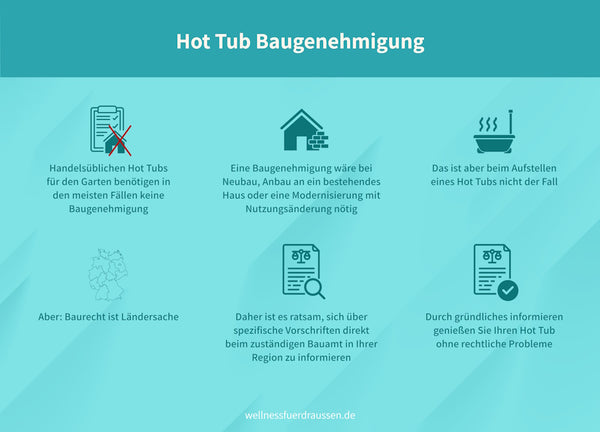
If you plan to integrate a standard hot tub into your garden , no structural work will usually be required. This means that in most cases you do not need a building permit . Since hot tubs are structural installations and are not considered buildings that require a permit, they are exempt from any procedures.
A building permit would be necessary if it were a new build, an extension to an existing house or a modernization that would result in a change of use. However, this is not the case when installing a hot tub.
However, it is important to note that legal regulations can vary from state to state. Building law is a state matter.
It is therefore advisable to contact the responsible building authority directly to find out about the specific regulations and requirements in your region.
By obtaining this information in advance, you can ensure that you comply with all necessary permits and approval processes and can enjoy your hot tub without legal hassle.
Here in Baden-Württemberg the following applies:
The hot tub is a structural facility (and not a building that requires approval).
The State Building Code for Baden-Württemberg (LBO) says about the “Procedure-free projects 8”:
- b) facilities used for garden use, garden design or the appropriate arrangement of gardens, excluding buildings and fences,
- f) air-supported swimming pool roofs with an indoor floor area of up to 100 m²;
So that you can check the regulations that apply to your federal state, we have listed the links to the state building regulations of the individual federal states here:
- Baden-Württemberg
- Bavaria
- Berlin
- Brandenburg
- Bremen
- Hamburg
- Hesse
- Mecklenburg-Western Pomerania
- Lower Saxony
- North Rhine-Westphalia
- Rhineland-Palatinate
- Saarland
- Saxony
- Saxony-Anhalt
- Schleswig-Holstein
- Thuringia
Hot Tub Distance to Neighbor
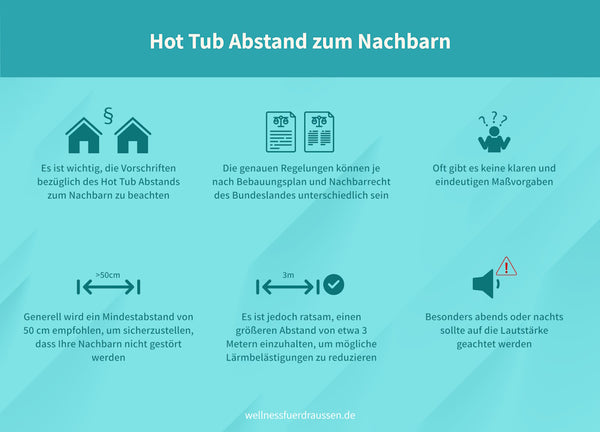
If you want to buy a hot tub and set it up in your garden, it is important to observe the regulations regarding distance from neighbors. The exact regulations can vary depending on the development plan and neighbor law of the state.
For example, the law on neighbouring rights (Neighbouring Rights Act - NRG) for Baden-Württemberg states in Section 6 Paragraph I: " Installations that threaten to cause damage or cause disruption may only be installed at such a distance from the border and only under such precautions that they do not harm neighbours."
However, the exact distance is not defined, not to mention the question of whether a hot tub is a damaging or disruptive facility.
In this respect, everything is open.
However, in general, a minimum distance of 50 cm is recommended to ensure that your neighbors are not disturbed. However, it is advisable to maintain a greater distance of around 3 meters to reduce possible noise disturbances.
This is especially important if you plan to use the hot tub in the evening or at night, as sound can easily travel through the quiet surroundings. By maintaining an appropriate distance, you show consideration for your neighbors and avoid potential conflicts.
Traditional hot tubs are heated with a wood stove, so are they considered a "fireplace" in the sense of the model building code ? In that case, a distance of 3m would be required.
But the Model Building Code states, “Fireplaces are fixed installations or devices in or on buildings that are designed to generate heat through combustion.” But since hot tubs are mobile and not fixed, they do not fall under this criterion.
Product tip: Hot tub with oven
As an overview: There are a few rules of thumb to follow when maintaining the correct distances from the property line in Germany. For buildings, a distance of at least 3 meters should be maintained, while outbuildings need a distance of 1-2 meters. Fences up to 180 cm high should have a distance of 50 cm from the property line, while plants up to 2 meters tall also need a distance of 50 cm. For plants that grow over 2 meters tall, a distance of 2 meters should be maintained. However, it is important to note that the exact regulations can vary depending on the federal state.
It is best to check with your local building department or attorney about the specific regulations in your area to ensure you meet all requirements.
Hot Tub Wood Stove (BImSchV)
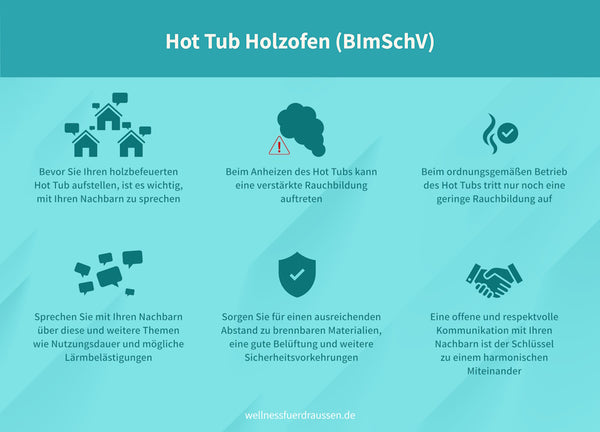
Before you install your wood-fired hot tub, it is important to talk to your neighbors and make sure they are OK with your plans.
Since increased smoke may occur when heating the hot tub , it is advisable to inform your neighbors and clarify whether this is acceptable to them. It is also important to emphasize that when the hot tub is operated properly, only minimal smoke will be produced.
Make sure you take the necessary safety precautions, such as keeping a sufficient distance from flammable materials and ensuring good ventilation. Also, talk to your neighbors about the planned period of use and the possible noise disturbance to avoid any inconvenience.
Open and respectful communication with your neighbors is the key to harmonious coexistence and allows you to enjoy your wood-fired hot tub to the fullest.
Product tip: Hot tub with acrylic tub and wood stove
In most federal states and districts, wood-fired hot tubs are exempt from the 1st Federal Immission Control Ordinance (1st BImSchV). The 1st BImSchV states: "Sections 4 to 20 and sections 25 and 26 do not apply to combustion systems designed to generate hot water in bath stoves."
This means that you can use your hot tub without worrying about complying with emission limits. Wood-fired hot tubs are private bathing stoves and are therefore not subject to the provisions of the 1st BImSchV.
However, there are now exceptions, such as the Bavarian State Ministry for the Environment and Consumer Protection. There, hot tubs fall under the 1st BImSchV.
Hot Tub Water Disposal
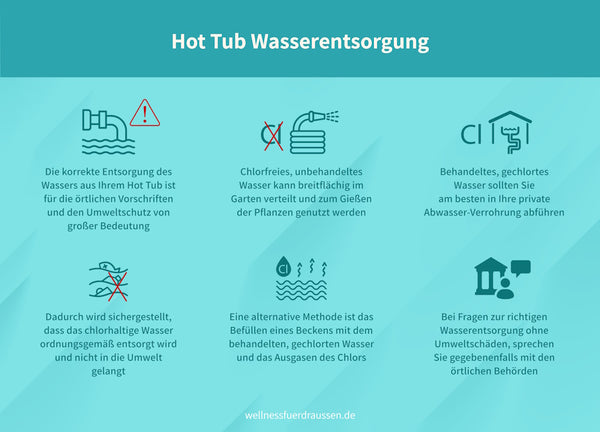
Properly disposing of water from your hot tub is very important to ensure you comply with local regulations and protect the environment.
Case 1: untreated, unchlorinated water
If it is normal, untreated water without chlorine, you can spread it widely around your garden and use it to water your plants. However, it is important to make sure that the water stays on your own property and does not accidentally flood something at your neighbor's.
One way to ensure this is to use a drain hose that directs the water directly into a large rain barrel. From there, you can then use the water to water your plants.
Case 2: treated, chlorinated water
Treated, chlorinated water should ideally be drained into your private sewage system, for example into the drain from the bathroom or similar. This ensures that the chlorinated water is disposed of properly and does not enter the environment.
An alternative method is to fill a pool with the treated, chlorinated water and let the chlorine off-gas. To do this, let the pool sit for a few days until all the chlorine has evaporated. You can then dispose of the water in the garden or on a lawn, as it no longer contains any harmful chemicals.
Remember that it is important not to simply discharge the water into sewers or surface waters such as streams or ponds as this can cause environmental damage. Therefore, always follow local regulations and speak to local authorities if necessary to ensure you are taking the correct steps to dispose of water.
Hot Tub electrical connection

The electrical connection for your hot tub depends on the equipment and components you have installed.
For normal equipment with lighting and a few nozzles, a 230 V Schuko plug is sufficient. This standard plug is available in most households and enables easy and convenient installation.
However, if you have installed a heater or other components with an output of more than 3.5 kW, you will need a 400 V CEE plug with 16 A. This plug offers higher performance and ensures safe operation of your hot tub system.
It is important to ensure the correct plug connection during installation to avoid possible power overloads, so always check the technical requirements of your hot tub components and make sure you use the appropriate plug.
If you are unsure, we recommend consulting a professional to ensure that your hot tub is powered correctly and safely.
Conclusion
In conclusion, there are few or no legal regulations for hot tubs. As a rule, the responsibility for complying with safety standards and neighborhood harmony lies with the owner. However, it is advisable to familiarize yourself with the regulations in force for similar products, such as swimming pools or whirlpools, in order to minimize potential risks.
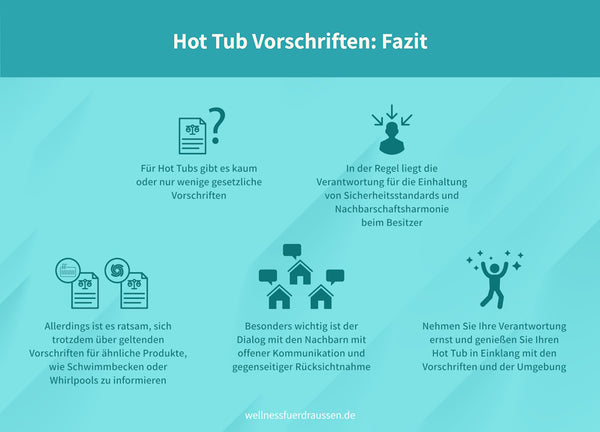
Dialogue with neighbours is particularly important. Open communication and mutual consideration can help maintain a harmonious relationship. Remember to inform your neighbours about your plans and listen to any concerns they may have.
Would you like to learn more about hot tub regulations and safety measures? Sign up for our email list and we will send you important updates in your inbox. As a hot tub owner, you should always stay informed about current regulations and best practices to ensure your safety and that of your neighbors.
Take your responsibility seriously and enjoy your hot tub in accordance with the regulations and the environment. With the knowledge and precautions in mind, you can spend relaxing and worry-free hours in the hot tub.
